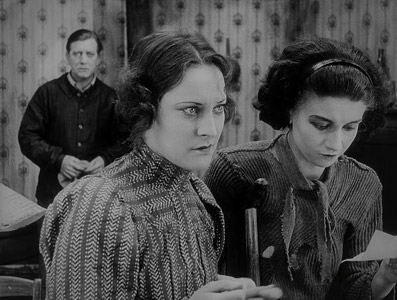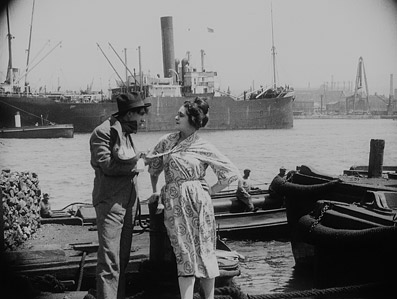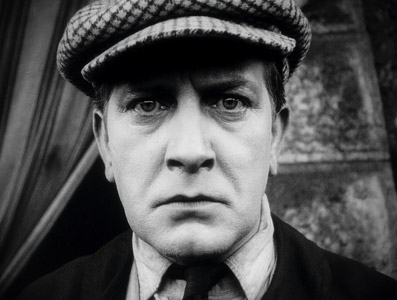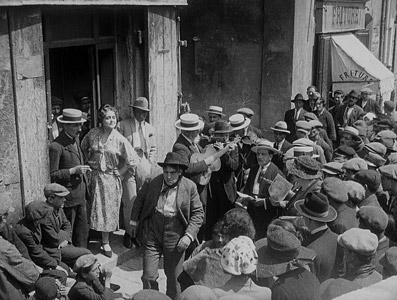| |
"A man walking, any man, a passerby: today's reality preserved for eternity by art. Embalmed in motion." |
| |
Jean Epstein, Bonjour cinéma, 1921 |
| |
"Cœur fidèle is the triumph of impressionism of movement, but it is also something else – the triumph of the modern spirit. Its images were seemingly in 3D; they literally burst from the screen, to such an extent that, in theatres, audiences suffered physically from dizziness or nausea as they watched the carousel whirl around." |
| |
Henri Langlois, Cahiers du cinéma, June 1953 |
Jean Epstein's Cœur fidèle / True Heart (1923) is one of the most innovative and influential films of the late silent-era. A pioneering, poetic classic of the narrative avant-garde shot in and around the old port of Marseilles, it also prefigured Poetic Realism and Neo-Realism. Warsaw-born Epstein was just 26-years-old when he made Cœur fidèle and cinema itself wasn't much older; he brought all his young energy, his enthusiasm for experiment, and his love for the young medium to bear on this exhilarating, exuberant film.
Cœur fidèle tells the tragic tale of Marie (Gina Manès), an orphan cruelly exploited by her foster parents in their quayside bar. Her emotions are stretched to breaking point in the tug-of-war between her true love, Jean (Léon Mathot), and the film's brutish baddy, Petit Paul (Edmond van Daële). Jean confronts the predatory thug at the bar but is outnumbered by his rival's gang. Petit Paul immediately drags Marie off to his hometown, where a fair is taking place. Marie, wrapped in streamers as if in chains, is forced into a symbolic wedding on a carousel. Jean tracks Marie and Petit Paul down. During a fight between the two men, a gendarme is stabbed. Jean is jailed for a year. After his release he visits Marie, now mother to a sickly child, at the hovel she inhabits with Petit Paul. A disabled neighbour, Mlle Marice (brilliantly played by Epstein's sister, Marie), acts as a go-between between Marie and Jean; with her help they meet regularly and secretly at the flat. When a waterfront prostitute (Madeleine Erickson) alerts Petit Paul to the situation, the scene is set for the film's violent climax.

The simple story of a love 'for ever' holds our attention throughout, but it is incidental to Jean Epstein's scintillating exploration of cinema's technical possibilities. In Cœur fidèle he devised and deployed every technique of camerawork and editing then imaginable, experimenting with established devices and inventing others. He used the tried-and-tested tropes of silent cinema (opening and closing Irises, intertitles, exaggerated acting styles), but also broke new ground with his use of filters and double exposure, slow and fast motion, wipes and dissolves, angled shots, non-linear flashback sequences, freeze frames, close-ups and rhythmic montage. Cœur fidèle feels like a film in which every frame has been carefully considered and asked to pay its way. That sense of respect, even reverence for the image is intensified by a recurring filmic device: images are often revealed in their full purity only after a screen of gauze or layer of lace is withdrawn from the frame, thus drawing the veil on beauty.
While filming the fairground scenes Epstein strapped his camera to a merry-go-round, to create a high-speed whirling sequence that provides visual expression of Marie's dizzying experience of thwarted love. For the film's first audiences, unfamiliar with flight as they would have been, the sight of the carousel's replica planes and the surrounding landscape circling the screen would have been unprecedented and disorientating. These scenes brilliantly convey Marie's feeling of being ensnared. Epstein's experiments with superimposition were similarly novel and reflected inner emotions equally effectively. After Petite Paul drags Marie off, Jean waits for her at their usual waterfront rendezvous. His tormented thoughts of Marie are reflected in a series of close-ups of her face, superimposed on or beneath waves. She looks, by turns, saddened, stunned, pensive and angry. As Jean's hopes that Marie will appear evaporate, a final close-up of her face seems to sink beneath the water. The sea, ancient repository of our deepest fears and aspiration for change, features often as a metaphor for Jean and Marie's dreams of a place and life beyond their port and poverty.
Epstein's use of close-ups was another of his innovations, one as well suited to silent cinema as it was well served by the strong faces of his principal actors. The film is worth watching for Gina Manès's performance alone. Her acting, generally more restrained than that of the rest of the cast, is excellent, even when taken out of context and judged by contemporary standards of realism. Only Marie Epstein matches her stride for stride. Manès's eyes are extraordinary; when they are flooded with light they seem to burn the screen with an incandescent aura.

Extreme close-ups allowed Epstein to depict individual feelings with an accuracy unusual for its time, but it also allowed him to imbue whole scenes with intense emotion. The scene in which Jean challenges Petit Paul in the bar is a case in point: the sequence of close-ups that drive the scene places us within the situation. In a short scene of real power over two-dozen close-ups of faces and fists are rhythmically edited in such a way that we are drawn into the circle of violent confrontation, to unsettling and claustrophobic effect. There are moments in the film when extreme close-ups are used in ways that predict subliminal advertising; for example, when the garish, nightmarish heads of fairground horses and bulls send signals about the horror of Marie's effective enslavement. Although nearly nine decades have passed since Cœur fidèle was released, the film was built to last and such scenes have lost little of their force in the interim, so the film feels fresh and looks modern.
When Epstein wrote the script for Cœur fidèle with his talented sister, his interest lay, as I have suggested, mainly in experiment; his heart wasn't in it. He claimed 'he' dashed it off in a single night, making no mention of Marie. Ok, so, like D.W. Griffith, whose work he admired, he told white lies and was a shameless self-publicist, but he was also an honest and influential film theorist who advanced cinema's cause with unwavering commitment. In his first book, Bonjour cinéma (1921), Epstein enthusiastically extolled cinema's virtues, just as it was leaving the days of the diorama, the panorama and the music hall behind it and establishing itself as a serious art form. He says that sight is the most developed sense and that cinema constitutes a new system of consciousness while greeting cinema as a unique medium combining art and science, thought and feeling, motion and light. Life, Epstein suggests, isn't a linear narrative but, rather, a series of situations that might lead anywhere; what matters, in cinema as in life, are the small movements and moments that comprise our continuous movement through time, frame by frame or day by day. Thus, for Epstein, "Cinema is true. A story is a lie."
Epstein criticism helped to outline and define the language of cinema most tellingly in his elaboration of the concept of Photogénie. As Robert Farmer points out in his Senses of Cinema article on Epstein, Photogénie was a way of thinking about film that insisted cinema was more than merely filmed theatre or filmed writing. It defended the specificity of cinema, declared that the camera could reveal thing often ignored by or invisible to the human eye, and argued that film must marginalise narrative in favour of the image. There are unmistakable echoes of Epstein's theories of Photogénie in Dziga Vertov's theories of the Kino-Eye ("The film drama is the opium of the people . . . down with Bourgeois fairytale scenarios . . . Long live life as it is!"). Epstein's criticism anticipated the New Wave's politique des auteurs, not only by separating directors capable of producing great art from those who were not, but also by separating spectators capable of appreciating the art of film from those who were not. It amounted to a manifesto for the new medium, with particular emphasis placed on the vitality of the close-up and montage, movement and rhythm.

Epstein didn't always practice what he preached. He was too interested in conveying emotion and in reaching a wide audience to totally eschew narrative in favour of cinéma pur. He compromised his vision when he indulged the public's thirst for storytelling, its hunger for what Jeanette Winterson has called "the life affirming lie." Introducing Cœur fidèle to students in Montpellier, Epstein says that he wrote a melodrama, "to win the confidence of those who still, quite wrongly, maintain that only the basest melodrama is capable of capturing the public's interest." He aimed at a story ". . . so sober, so simple, that it might approach the nobility and excellence of tragedy." He adds: "I hardly need add – in a low voice – that, if I wanted to win their confidence, it was in order to trick them in favour of a superior interest." That superior interest was the cinema, to which his heart was always true, even when he appeared to betray it.
If it is understandable why Epstein chose to tell a story, it is, nonetheless, a shame he did so. The story rings true when it chimes with contemporary concerns (its themes of poverty, male violence, despair and love against the odds are ones we can relate only too well) but the manner of its telling, while advanced for its day, often feels as dated as the overblown, theatrical acting styles of silent cinema. Cœur fidèle succeeds best when Epstein is true to his instincts and ideas. It derives its power as much from its locations as his flamboyant experimentation. Its setting in the old port of Marseilles and the demi-monde of working class life produces some memorable documentary moments. One dockside scene involving Petit Paul and the prostitute seems set up to catch a cargo ship pulling out of harbour. That would be fascinating enough in itself, but the camera also accidentally catches a passing barge in the foreground and captures a nimble wharfie as he skillfully vaults quayside obstacles to catch it up. Small movements and moments like that are frequent in the film.

In taking the camera out onto the streets of Marseilles and anchoring the film in real life, Epstein played to one of cinema's strengths: its documentary capacity to report life as it is and was lived. There they are, those now dead, alive before our eyes; the milling crowds in the film's famous fairground scenes, the working stevedores of the port that once was, the crowd that gathers to hear music in the milieu from which singers Bressens and Piaf sprang. Epstein established many of the settings and sensibilities that would define Poetic Realism. His predilection for realistic settings, his interest in documentary verisimilitude, and his sense of solidarity with those on the margins of society (an affinity perhaps prompted by his own Jewishness) continued to influence others, even after the advent of sound. He contributed to the creation of a distinct French film culture at odds with Hollywood. Epstein's influence is discernible, for instance, in films as various as those made by Marie Epstein with Jean Benoit-Levy, notably La Maternelle (1933); in René Clair's Le voyage imaginaire (1926) and Sous les toits de Paris/Under the Roofs of Paris (1930); Marcel Pagnol's Marseilles Trilogy - Marius (1931), Fanny (1932) and César (1936); Jean Vigo's À propos de Nice (1930) and L'Atalante (1934); and Jean Renoir's Boudu sauvé des eaux/Boudu Saved from Drowing (1932) and La Bête humaine (1938) – not to mention Vertov's Man with a Movie Camera (1929). Silly scripts and financial problems bedevilled Epstein's later work, but when he returned, as he did time and again, to documentary, the results were always interesting.
Epstein's filmmaking career began at a time when the new medium was being created on the hoof and directors were learning from one another's every innovation. Epstein was a supremely gifted directors' director. Not for nothing did Luis Buñuel approach Epstein in the early 1920s and beg him to pass on all he knew about the craft of filmmaking. Epstein took Buñuel on as his assistant but fired him when the Spaniard refused to work with Abel Gance; Buñuel loathed Gance's work almost as much as Epstein admired it. Like many directors of the day (notably the Soviet directors Dovzhenko, Eisenstein, Ekk, Pudovkin and Vertov), Epstein was hugely influenced by Abel Gance's use of accelerated montage in La Roue/The Wheel (1922). Jean Cocteau spoke for many when he said: "There is cinema before and after La Roue just as there is painting before and after Picasso." François Truffaut later paraphrased Cocteau when he said: "There is cinema before Godard and cinema after Godard." Innovation follows innovation and a line of descent can be traced from Jean Epstein and Jean Cocteau, through Jean Renoir and Jean Vigo, to Jean-Luc Godard and Jean-Pierre Melville.

Epstein called the train crash sequences in Abel Gance's La Roue, "the most classical sentences yet written in the language of cinema." He created many beautiful cinematic sentences of his own and may have created more but for the advent of sound. Epstein attempted an accommodation with sound cinema by adding the concept of Phonegénie to his earlier concept of Photogénie. Discussing music for silent films in The Cinema Continues (1930), he wrote: "Let it supply a rhythm, preferably a monotonous one. One cannot look and listen at the same time . . . Music which attracts attention, or the imitation of noises, is simply disturbing." One suspects that he would have been delighted with Maxence Cyrin's wonderful score for this DVD release of Cœur fidèle. It is exquisite, subtle, occasionally sublime, but always unobtrusive.
Riddled with paradox though Epstein's writing and filmmaking practice was, it set the standard for much that followed and established a cinematic ideal that has not yet been entirely realised. Epstein was ahead of his time, even ahead of himself. As Jacques Rancière suggests in his introduction to Film Fables (Berg, 2006), cinema's involution resulted from the double assault of the talkies (la coupure du parlant), which largely nipped attempts to create a language of images in the bud, and Hollywood, which reduced directors to the role of illustrators of scripts, reproducers of rationalised, standardised commercial plots. Epstein and the avant-garde tradition hinted at what cinema might have been, before its partial defeat by its enemies – narrative and money. Cœur fidèle is beautiful, exciting and strikingly modern. It removes us from an age in which concentration spans have been shattered into shards, where many see no further than their mobiles or computers, and returns us to a time when the human eye innocently marveled, in rapture, at images. It provides us with an opportunity to watch again what cinema can be or might have been.
Masters of Cinema have already set the bar for high definition transfers of silent films with their Blu-ray release of Murnau's City Girl, and given that Cœur fidèle was made seven years earlier, it would be unreasonable to expect the transfer here to look as good. But it does. And how. Yes, some damage and the scratches remain, and yes, there is sometimes a loss of detail at either end of the tonal range, but in all other respects the picture on the Blu-ray version is little short of stunning for an almost ninety year old film. There is a wonderful richness to the monochrome imagery, particularly evident in the mid-tones and the deepness of the blacks, and the level of detail is at times genuinely astonishing, outstripping HD transfers of a good many more modern films. Surfaces, textures and patterned clothing are particularly well rendered, and there are close-ups where I swear you could count almost every head hair and facial crease, while clarity of the wide shots vividly brings the locations to life. This does mean that the film grain is also more visible, but this is never a problem and it does not feel artificially enhanced. If you do not yet have a Blu-ray player then be assured that the DVD transfer is also an impressive beast, but it cannot match the richness and fine detail of its HD brother. This is the sort of transfer we bought into Blu-ray to see.

The DTS-HD Master Audio 2.0 stereo soundtrack plays host to Maxence Cyrin's excellent piano score, which as a modern recording is clear and distortion free, and boasts both a solid bass and clean high notes.
This eagerly anticipated DVD release of Cœur fidèle (No 19 in the Masters of Cinema series) comes complete with a collectable, delectable biblio containing credits, on-set images of cast and crew, stills from the film, and a wealth of information to sate our appetite to know more of its gifted director. Included here are the text of Epstein's address to students prior to a 1924 screening of the film in Montpellier, extended extracts from Epstein's essays For a New Avant-Garde and Worlds Fall into a Light-Space, a gushing review of Cœur fidèle written by René Clair upon its release, and heartfelt homages to Epstein delivered, shortly after his death in 1953, by Jean Cocteau, Abel Gance, Marcel L'Herbier and Henri Langlois. The booklet also features detailed notes on the painstaking restoration project that lead to this important presentation and notes, with explanatory images, on correct viewing protocol. Like the film itself, this publication was clearly a labour of love, one that does great credit to a great film.
The only on-disc extra is a Photography Gallery containing 30 production stills, including portraits of crew members, although several of the pictures are doubled up by showing them in their entirety, then closing in on a detail.
Cœur fidèle is a masterpiece of the late silent-era filmed largely on location in Marseilles. Jean Epstein's complete abandonment to the intoxicating pleasures of cinematic experiment resulted in a classic that passes the test of time without the need for colour or for sound. Cœur fidèle creates film history, frame by daring frame. Riveting as a realist work replete with glimpses of the kind of working port that once supplied the world, the film also offers tragedy, in the form of a fable of the good, the bad and the very beautiful. Once seen, the extraordinary eyes of Gina Manès will never be forgotten. This magnificent Masters of Cinema restoration, the first UK DVD and Blu-ray release of Cœur fidèle, does copious justice to the film's luminous brilliance and should go a long way towards consolidating Epstein's growing, if posthumous reputation as one of cinema's great inventors. Highly recommended.
|